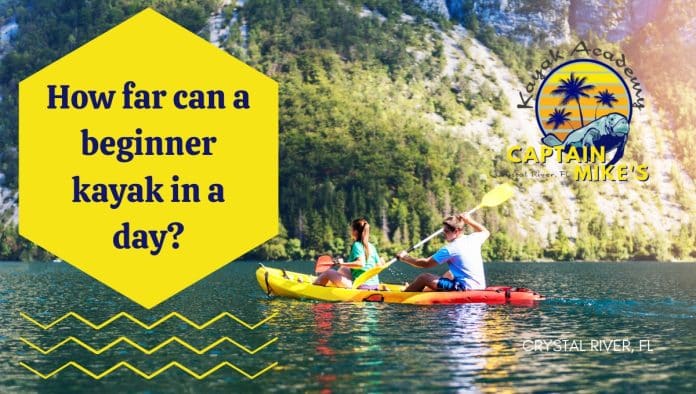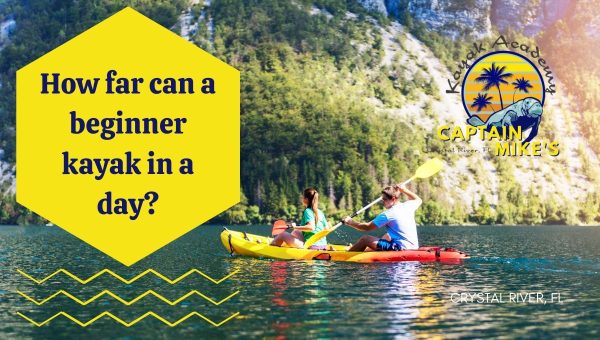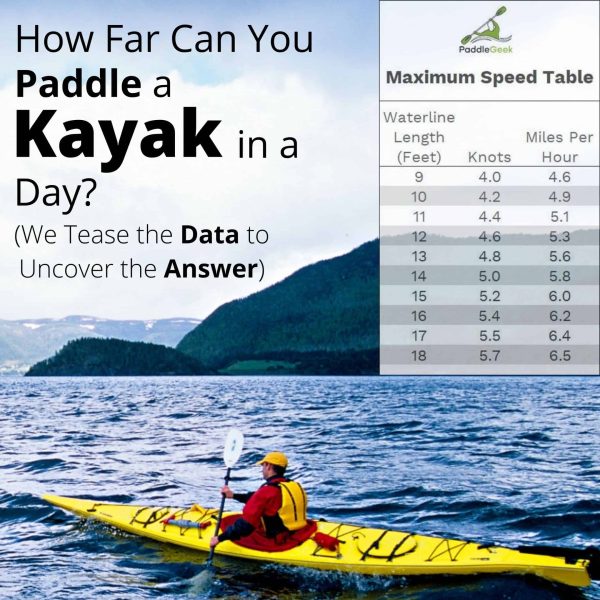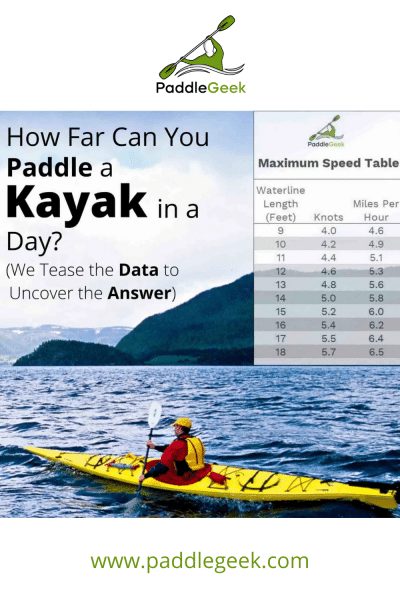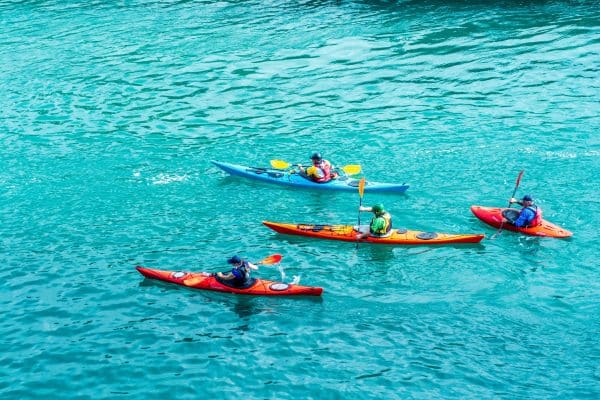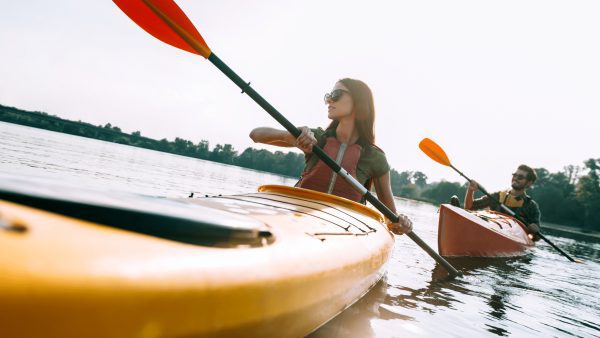Let’s embark on an aquatic adventure as we explore the question that has intrigued many adventure enthusiasts: how far can one paddle a kayak in a day?
From serene lakes to rushing rivers, the possibilities seem endless. Join us as we navigate this thrilling journey, discover the factors that impact kayaking distances, and uncover tips to maximize your paddling potential.
Get ready to dive into the thrilling world of kayaking and discover just how far you can go in a day!
Factors That Affect Kayaking Distance
The kVarious factors, including physical fitness, weather conditions, water conditions, and paddling technique can influence kayaking distance. Understanding how these factors impact your kayaking distance can help you plan and prepare for your paddling adventures.
Physical Fitness
Physical fitness determines how far you can paddle a kayak in a day. The more physically fit you are, the longer you can sustain a paddling rhythm and maintain a consistent pace. Cardiovascular endurance, muscular strength, and flexibility contribute to your overall physical fitness level and can affect your kayaking distance.
To improve your physical fitness for kayaking, consider incorporating regular cardiovascular exercises like running, swimming, or cycling into your routine. Strength training exercises targeting the muscles used in kayaking, such as the core, shoulders, and arms, can also be beneficial. Additionally, stretching and practicing yoga can help improve flexibility, allowing for more efficient and comfortable paddling.
Weather Conditions
Weather conditions can significantly impact kayaking distance. Strong headwinds, rough waters, or adverse weather conditions can slow your paddling speed and make it more challenging to cover long distances. On the other hand, favorable weather conditions with calm winds and clear skies can allow for faster and more enjoyable paddling experiences.
Before embarking on a kayaking journey, it is essential to check the weather forecast for your intended route. Be aware of potential storms or adverse weather patterns affecting your safety and paddling distance. Adjust your plans accordingly and consider rescheduling if necessary.
Water Conditions
Water conditions like currents, tides, and waves can also impact kayaking distance. Paddling against solid currents or fighting against high waves can impede your progress and make it more challenging to cover long distances. Additionally, tidal patterns can affect the timing and direction of your paddling, influencing how far you can kayak in a day.
To maximize your kayaking distance, choose routes with favorable water conditions. Research the area’s tidal patterns, currents, and wave forecasts and plan your journey accordingly. Paddling with or alongside the current can significantly enhance your overall distance and paddling efficiency.
Paddling Technique
Proper paddling technique is crucial for optimizing kayaking distance. Efficient paddling not only allows you to conserve energy but also enables you to maintain a steady speed and cover longer distances. A good paddling technique includes proper body posture, grip, and paddle stroke technique.
Maintain an upright posture and engage your core muscles to provide stability and power during each stroke. Hold the paddle with a relaxed grip and ensure your hands are positioned shoulder-width apart. When executing the paddle stroke, focus on using your core and upper body strength rather than relying solely on your arms.
Taking the time to practice and refine your paddling technique can greatly enhance your kayaking distance. Consider taking lessons or joining a kayaking group to learn from experienced paddlers and improve your technique. With the right technique, you can easily increase your efficiency on the water and paddle longer distances.
Types of Kayaks and Their Influence on Distance
The type of kayak you choose can also significantly impact the distance you can paddle in a day. Different kayaks are designed for specific purposes and offer varying levels of performance and speed. Understanding the characteristics of different kayak types can help you select the most suitable option for your desired paddling distance.
Recreational Kayaks
Recreational kayaks are popular among beginners and casual paddlers. They are generally shorter and wider than other kayak types, providing stability and ease of maneuverability. While recreational kayaks are well-suited for calm waters such as lakes and slow-moving rivers, their wider hull design and slower speeds may limit their efficiency for covering long distances.
If you plan to paddle longer distances, it may be worth considering a different kayak type that offers incredible speed and efficiency. However, if you prefer a leisurely pace and prioritize stability and comfort over speed, a recreational kayak can still be suitable for shorter journeys.
Touring/Sea Kayaks
Touring or sea kayaks are designed for long-distance paddling in open-water environments such as lakes, rivers, and coastal areas. They are longer and narrower than recreational kayaks, allowing for increased speed and better tracking in a straight line. Touring kayaks often feature more storage space and added stability, making them ideal for extended kayak camping trips.
Due to their streamlined design and enhanced performance, touring kayaks are well-suited for covering long distances. They can cut through the water more efficiently, enabling you to maintain a faster pace and travel greater distances within a day. If you aspire to embark on multi-day kayak expeditions or cover significant distances, a touring or sea kayak is recommended.
Sit-on-Top Kayaks
Sit-on-top kayaks are popular for recreational paddling and warm-weather environments. Unlike traditional kayaks, sit-on-top kayaks feature an open-top design, providing ease of entry and exit and eliminating the feeling of confinement. They are generally broader and more stable, making them suitable for beginners and those looking for a relaxing paddling experience.
While sit-on-top kayaks offer stability and simplicity, their more comprehensive hull design can result in slower speeds than other kayak types. This slower pace may limit the distance you can cover within a day. However, for leisurely explorations, fishing trips, or paddling in calm waters, sit-on-top kayaks can still provide an enjoyable experience.
Inflatable Kayaks
Inflatable kayaks have gained popularity recently due to their portability and convenience. They can be easily transported and inflated, making them an excellent choice for those who don’t have access to dedicated kayak storage or transportation. Inflatable kayaks vary in design, ranging from recreational models to more performance-focused options suitable for longer distances.
While inflatable kayaks can be a convenient option for recreational paddling, it’s important to note that they may not offer the same level of speed and efficiency as hardshell kayaks. The flexibility of the inflatable material can result in slightly slower paddling speeds, which could impact your overall distance coverage. However, advancements in design and materials have led to the creation of inflatable kayaks with improved performance capabilities.
When selecting an inflatable kayak, consider models specifically designed for longer distances or touring purposes. These kayaks often feature enhanced tracking systems, streamlined shapes, and increased stability, allowing for more efficient and comfortable long-distance paddling.
This image is the property of threesisterskayakrental.com.
Average Paddling Speeds
Understanding average paddling speeds for different skill levels can give you a better idea of how far you can expect to kayak in a day. While individual abilities and conditions vary, the following speed ranges provide a general guideline for estimating potential distance coverage.
Beginner Level
For beginners, starting at a comfortable pace and gradually building endurance and paddling skills is essential. On average, beginner paddlers can maintain a speed of around 2 to 2.5 miles per hour (3.2 to 4 kilometers per hour). At this pace, covering a distance of 10 to 12 miles (16 to 19 kilometers) in a day is a reasonable goal.
As a beginner, focus on developing proper paddling techniques, building endurance, and familiarizing yourself with the basics of kayaking. Gradually increase your distance and speed as you become more comfortable and confident on the water.
Intermediate Level
Intermediate paddlers have gained more experience and skill in kayaking, allowing for increased speed and endurance. At this level, paddlers can maintain an average speed of 3 to 4 miles per hour (4.8 to 6.4 kilometers per hour). With this pace, covering 15 to 20 miles (24 to 32 kilometers) daily is attainable for many intermediate paddlers.
To reach the intermediate level, continue practicing and refining your paddling technique and building on your endurance and strength. Take longer paddling journeys, explore different water environments, and challenge yourself to improve your overall speed and distance coverage.
Advanced Level
Advanced paddlers possess high skill, experience, and physical fitness. Depending on conditions, they can maintain speeds of 4 to 6 miles per hour (6.4 to 9.7 kilometers per hour) or even more. Distance coverage of 20 to 30 miles (32 to 48 kilometers) or more is within reach for advanced paddlers daily.
Achieving the advanced level requires dedication, training, and a deep understanding of kayaking techniques. Continuously challenge yourself with more extended and demanding paddling expeditions to improve your stamina, speed, and endurance. Seek professional guidance or join kayaking groups to learn from experienced paddlers and further enhance your skills.
Calculating Kayaking Distance
Accurately calculating kayaking distance can help you plan your trips, estimate travel times, and set realistic goals. Different methods, such as time and speed calculations, landmarks and GPS reference points, or online mapping tools, can provide valuable information about your distance coverage.
Time and Speed
One of the simplest ways to estimate kayaking distance is by using your average paddling speed and the time spent on the water. You can obtain an approximate distance traveled by multiplying your speed in miles per hour or kilometers per hour by the number of hours you plan to kayak.
For example, if you maintain an average speed of 3 miles per hour (4.8 kilometers per hour) and plan to kayak for 6 hours, your estimated distance coverage would be 18 miles (28.8 kilometers).
While this method provides a rough estimate, factors such as wind, currents, and breaks can affect your speed and should be considered when calculating distance.
Landmarks and GPS
Landmarks and GPS devices can help you accurately measure distance while on the water. Identifying prominent landmarks or features along your route, such as islands, bridges, or shoreline landmarks, allows you to estimate the distance between each reference point.
To determine the distance between landmarks, you can use a handheld GPS device or smartphone app that provides navigation and distance tracking features. These tools can display your location in real time, allowing you to monitor your progress and overall distance covered.
Be sure to familiarize yourself with the features and operation of your GPS device or app before embarking on your paddling journey. Additionally, consider bringing a backup navigation method, such as a map and compass, in case of technological malfunctions or battery issues.
Online Mapping Tools
Online mapping tools can also be a valuable resource for calculating kayaking distance. Websites and apps like Google Maps or MapMyRun allow you to plot your intended route and receive an accurate distance measurement.
To use online mapping tools, enter your start and end points and select a route that follows the waterway you plan to kayak. The tool will provide a distance breakdown, allowing you to customize your route, explore alternative options, or set specific distance goals.
Remember that online mapping tools provide distance measurements based on established paths and may not account for water conditions, currents, or obstacles like rocks or fallen trees. Always exercise caution and adapt your plans accordingly while on the water.
This image is property of paddlegeek.com.
Recommended Kayak Routes
Choosing the correct kayak route can enhance your paddling experience and allow you to explore diverse environments. Whether you prefer serene lake settings, meandering rivers, or the allure of the coast, there are numerous recommended kayak routes to suit your desires.
Lake Routes
Kayaking on lakes offers calm waters, picturesque surroundings, and the opportunity for leisurely exploration. Popular lake routes include Lake Tahoe in California and Nevada, Maligne Lake in Alberta, Canada, and Lake District in England.
When planning a lake route, consider the distance and difficulty level that aligns with your skill level and goals. Ensure that the lake is suitable for kayaking, and check any necessary permits or regulations before leaving.
River Routes
Kayaking on rivers provides a dynamic and ever-changing experience as you navigate various currents and landscapes. River routes, such as the Colorado River in the United States or the Zambezi River in Africa, offer thrilling adventures for paddlers of different skill levels.
Before embarking on a river route, research the water conditions, such as water flow and potential obstacles like rapids or dams. Plan your trip according to your skill level, and consider joining a guided tour or seeking local advice for more challenging or remote river routes.
Coastal Routes
For those seeking a blend of natural beauty and exhilarating paddling, coastal routes offer a unique kayaking experience. Exploring rugged shorelines, sea caves, and marine life can mesmerize. Coastal routes may include destinations such as the Norwegian fjords, the Great Ocean Road in Australia, or the California coast in the United States.
Coastal kayaking requires careful planning and consideration of tidal patterns, wind conditions, and potential hazards such as cliffs and strong currents. Ensure you have the necessary skills, equipment, and knowledge to safely navigate coastal routes, or consider joining a guided tour led by experienced coastal paddlers.
Safety Precautions
Kayaking, like any water-based activity, requires adherence to safety precautions to ensure an enjoyable and safe experience. Before setting out on your kayaking adventure, consider the following safety measures:
Check Local Regulations
Research and familiarize yourself with local regulations that govern the waterways you plan to kayak. Different areas may have specific rules regarding access, permits, and restricted areas. Complying with these regulations ensures environmental preservation and your safety.
Wear Appropriate Safety Gear
Wearing appropriate safety gear is essential to minimize the risk of accidents and injuries while kayaking. A properly fitting personal flotation device (PFD) is crucial and should always be worn. Additionally, consider wearing a helmet, especially when kayaking in challenging river or whitewater environments.
Protective clothing, such as a wetsuit or drysuit, can provide thermal insulation and enhance buoyancy in colder water conditions. Sun protection, including hats, sunglasses, and sunscreen, should also be worn to guard against harmful UV rays.
Bring Essentials
Pack essential items to ensure your safety and comfort during your kayaking journey. These items may include a first aid kit, a whistle or signaling device, a compass or GPS device, a repair kit for your kayak, and a mobile phone or emergency communication device. Carrying extra water, snacks, and a waterproof bag for storing personal belongings is also recommended.
Inform Someone of Your Plans
Before embarking on a kayaking trip, inform a trusted individual about your intended route, estimated return time, and any emergency contact numbers. This information is crucial in case of an unforeseen situation or difficulties while on the water.
Consider leaving a written itinerary with a family member, friend, or local authorities. Communicate your plan to check in upon your return and agree on a protocol if you do not make contact within a designated timeframe.
This image is the property of i.pinimg.com.
Training for Long-Distance Kayaking
Training and preparing your body for long-distance kayaking journeys are essential for achieving your goals and maximizing distance coverage. Here are some training tips to help you build physical endurance and improve your overall paddling capabilities:
Building Physical Endurance
Kayaking long distances requires stamina and endurance. Incorporate cardiovascular exercises such as running, cycling, or swimming into your training routine to improve your aerobic capacity. Aim for at least 30 minutes of moderate to vigorous exercise three to five times weekly.
Gradually increase the duration and intensity of your cardiovascular workouts, simulating the demands of kayaking. Engaging in high-intensity interval training (HIIT) or long-distance training sessions can help improve your endurance and prepare your body for extended periods of paddling.
Strengthening Core Muscles
Core muscles are vital in maintaining stability and generating power during kayaking. Engaging in exercises that target your core muscles, such as planks, Russian twists, or seated medicine ball twists, can improve your kayaking performance and reduce the risk of injuries.
Incorporate strength training exercises focusing on the muscles used in kayaking, including the arms, shoulders, and back. Exercises such as bent-over rows, shoulder presses, and bicep curls can help build the strength and endurance required for long-distance paddling.
Practicing Efficient Paddling Technique
Efficient paddling technique is crucial, especially when kayaking long distances. Focus on refining your paddling form, body posture, and paddle stroke technique. Seek guidance from experienced paddlers or instructors who can provide valuable tips and help you adjust your technique.
Dedicate time to practicing proper body mechanics, including engaging your core, using your larger muscle groups, and maintaining a relaxed grip on the paddle. Recording yourself while paddling or using a mirror can provide visual feedback and enable you to identify areas for improvement.
Gradually Increasing Distance
Gradually increasing your distance is essential for developing the endurance and mental stamina required for long-distance kayaking. Start with shorter paddling sessions and progressively increase the duration and distance as your fitness and skill level improves.
Consider planning training sessions that mimic the conditions and distance of your intended long-distance journey. This can help build confidence, test your gear and equipment, and identify any adjustments or modifications that may be required.
Remember to listen to your body and avoid overexertion or pushing yourself beyond your physical limits. Rest and recovery are equally important as training to prevent injuries and allow your body to adapt and strengthen.
Achieving Long-Distance Kayaking Goals
Achieving long-distance kayaking goals requires dedication, perseverance, and careful planning. Here are some valuable tips to help you succeed in reaching your aspirations:
Setting Realistic Goals
Setting realistic and achievable goals is instrumental in maintaining motivation and focus. Consider your skill level, physical fitness, and paddling experience when establishing your distance goals. Start with smaller milestones and gradually increase the distance as you gain confidence and improve your paddling abilities.
Be mindful of your limitations and make adjustments to your goals when necessary. Factors such as weather conditions, water conditions, and unexpected obstacles may require flexibility in your plans. By setting realistic goals and adapting to changing circumstances, you can enjoy the journey and celebrate your progress.
Tracking Progress
Tracking your progress can provide a sense of accomplishment and help you stay motivated throughout your long-distance kayaking journey. Keep a paddling log or use a tracking app to record your distance covered, time spent on the water, and critical observations from each expedition.
Monitoring your progress allows you to identify patterns, evaluate your performance, and adjust your training or technique. Celebrate milestones and improvements, and reflect on each paddling experience to gain insights and learn from any challenges encountered.
Seeking Professional Guidance
Seeking professional guidance can be invaluable when striving to achieve long-distance kayaking goals. Consider joining local kayaking clubs or organizations that offer training programs and workshops. Experienced instructors can provide personalized guidance, teach advanced techniques, and help you overcome any specific challenges you may encounter.
Hiring a professional guide or coach may be beneficial if you are planning an extensive expedition or aiming for a significant distance accomplishment. These experts can provide insights into the best routes, enhance your kayaking skills, and ensure your safety and well-being during your journey.
This image is property of uploads-ssl.webflow.com.
Famous Long-Distance Kayaking Expeditions
Throughout history, numerous kayakers have embarked on incredible long-distance expeditions, pushing the boundaries of what is possible on the water. Here are a few noteworthy examples of famous long-distance kayaking expeditions:
Antarctic Kayaking Expedition
In 2017, a team of paddlers completed a groundbreaking kayaking expedition in Antarctica. Their journey covered over 1,300 miles (2,092 kilometers), navigating through treacherous waters and icy conditions. This historic expedition showcased the resilience, skill, and determination required for long-distance kayaking in extreme environments.
Amazon River Kayaking Expedition
The Amazon River, the world’s largest river, has been the setting for various long-distance kayaking expeditions. Paddling the Amazon River requires overcoming significant challenges, including navigating dense rainforests, experiencing rapidly changing water levels, and encountering wildlife. These awe-inspiring expeditions have showcased the awe-inspiring beauty and diversity of the Amazon.
Circumnavigation of Great Britain by Sea Kayak
Kayaking around the entire coastline of Great Britain is an extraordinary feat that a select group of paddlers has achieved. This massive journey covers approximately 2,000 miles (3,218 kilometers) and requires careful planning, determination, and physical endurance. Those who have completed this circumnavigation have experienced the diverse coastal landscapes and rich maritime heritage of the British Isles.
Conclusion
Kayaking is a versatile and rewarding activity that allows us to explore the beauty of the natural world from a unique perspective. Understanding the factors that affect kayaking distance, the different types of kayaks available, and the recommended routes enables us to plan and prepare for memorable adventures.
By considering physical fitness, weather conditions, water conditions, and paddling technique, we can optimize our distance coverage and enhance our overall kayaking experience. With proper training, realistic goal setting, and a passion for discovery, we can achieve remarkable long-distance kayaking accomplishments and create lifelong memories on the water.
This image is the property of uploads-ssl.webflow.com.

